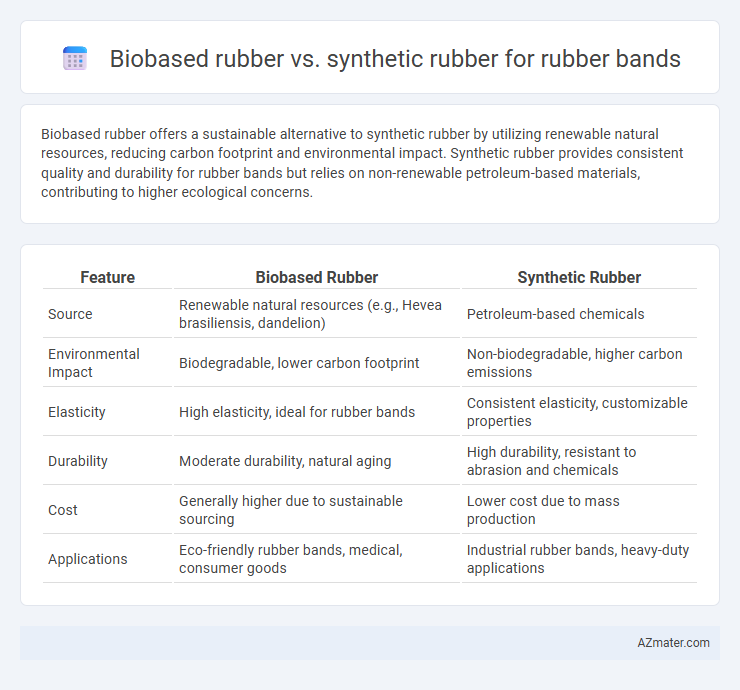Biobased rubber offers a sustainable alternative to synthetic rubber by utilizing renewable natural resources, reducing carbon footprint and environmental impact. Synthetic rubber provides consistent quality and durability for rubber bands but relies on non-renewable petroleum-based materials, contributing to higher ecological concerns.
Table of Comparison
| Feature | Biobased Rubber | Synthetic Rubber |
|---|---|---|
| Source | Renewable natural resources (e.g., Hevea brasiliensis, dandelion) | Petroleum-based chemicals |
| Environmental Impact | Biodegradable, lower carbon footprint | Non-biodegradable, higher carbon emissions |
| Elasticity | High elasticity, ideal for rubber bands | Consistent elasticity, customizable properties |
| Durability | Moderate durability, natural aging | High durability, resistant to abrasion and chemicals |
| Cost | Generally higher due to sustainable sourcing | Lower cost due to mass production |
| Applications | Eco-friendly rubber bands, medical, consumer goods | Industrial rubber bands, heavy-duty applications |
Introduction to Rubber Bands: Biobased vs Synthetic
Rubber bands are commonly made from either biobased rubber, derived from natural sources like Hevea brasiliensis latex, or synthetic rubber produced from petroleum-based polymers such as styrene-butadiene rubber (SBR). Biobased rubber offers renewable, biodegradable properties that reduce environmental impact, whereas synthetic rubber provides greater consistency, durability, and resistance to temperature and chemicals. The choice between biobased and synthetic rubber influences the elasticity, strength, and sustainability of rubber bands in various applications.
What is Biobased Rubber?
Biobased rubber is derived from natural, renewable resources such as rubber trees (Hevea brasiliensis) and other plants, offering an eco-friendly alternative to petroleum-based synthetic rubber. It contains natural polymers like polyisoprene, which provide elasticity and durability comparable to synthetic counterparts used in rubber bands. The use of biobased rubber reduces dependence on fossil fuels and decreases the environmental impact associated with manufacturing and disposal.
Overview of Synthetic Rubber
Synthetic rubber, primarily derived from petrochemical sources such as styrene-butadiene and nitrile butadiene, offers consistent quality, superior durability, and enhanced resistance to heat and chemicals compared to biobased rubber. This material's molecular structure allows for tailored properties, making it ideal for rubber bands requiring high elasticity and prolonged lifespan. Its widespread industrial production ensures cost-effectiveness and availability, positioning synthetic rubber as the dominant choice in rubber band manufacturing.
Manufacturing Processes Compared
Biobased rubber for rubber bands is derived from natural latex harvested from Hevea brasiliensis trees, involving processes like coagulation, drying, and vulcanization that emphasize sustainability and lower carbon footprint. Synthetic rubber is produced through polymerization of petrochemical monomers such as styrene and butadiene, requiring energy-intensive refining and chemical synthesis steps. Manufacturing biobased rubber results in biodegradable and renewable products, while synthetic rubber offers consistency and performance but relies on non-renewable fossil fuels.
Environmental Impact Assessment
Biobased rubber for rubber bands significantly reduces carbon emissions and reliance on fossil fuels compared to synthetic rubber, which is derived from non-renewable petrochemicals. Life cycle assessments indicate biobased rubber offers lower environmental impact through biodegradability and sustainable cultivation practices, while synthetic rubber contributes to toxic pollution and higher energy consumption during production. Evaluating environmental impact assessment metrics, biobased rubber supports circular economy principles and reduces ecological footprint in rubber band manufacturing.
Mechanical Properties and Performance
Biobased rubber offers enhanced elasticity and superior tensile strength compared to synthetic rubber, making it ideal for durable rubber bands that require high stretchability and resilience. Its natural polymer chains provide better fatigue resistance and recovery, resulting in longer-lasting performance under repeated stress. Synthetic rubber, while cost-effective and consistent in quality, often exhibits lower mechanical strength and reduced environmental sustainability, affecting its long-term durability in rubber band applications.
Cost Analysis and Market Availability
Biobased rubber for rubber bands typically presents higher raw material costs due to limited large-scale cultivation and processing infrastructure compared to synthetic rubber, which benefits from established petrochemical supply chains. Market availability of biobased rubber remains relatively constrained, accounting for a small percentage of total rubber production, whereas synthetic rubber dominates with widespread production and consistent supply in the global market. Cost analysis indicates synthetic rubber provides a more economical option for manufacturers, though increasing demand for sustainability may shift future market dynamics.
Biodegradability and End-of-Life Considerations
Biobased rubber, derived from natural sources like latex, offers superior biodegradability compared to synthetic rubber, which is typically petroleum-based and resistant to microbial degradation. At the end of life, biobased rubber bands decompose more readily in composting environments, minimizing landfill accumulation and environmental impact. Synthetic rubber bands often persist in ecosystems, contributing to microplastic pollution and requiring energy-intensive recycling or disposal methods.
Applications in Industry and Daily Life
Biobased rubber offers enhanced sustainability with reduced carbon footprint, making it ideal for eco-friendly rubber bands used in food packaging and medical supplies. Synthetic rubber provides superior durability and elasticity, preferred in industrial applications like automotive hoses and heavy-duty elastic bands. Both materials cater to diverse needs, with biobased rubber gaining traction in environmentally conscious markets and synthetic rubber dominating high-performance sectors.
Future Trends: Sustainability in Rubber Band Production
Biobased rubber is gaining traction in rubber band production due to its renewable sources like guayule and dandelion, reducing dependence on fossil fuels and lowering carbon footprints. Synthetic rubber, primarily derived from petroleum, faces increasing scrutiny over environmental impact and challenges in biodegradability, driving innovation towards greener alternatives. Future trends emphasize enhanced sustainability through biotechnological advancements and circular economy models to create eco-friendly, high-performance rubber bands.

Infographic: Biobased rubber vs Synthetic rubber for Rubber band
 azmater.com
azmater.com